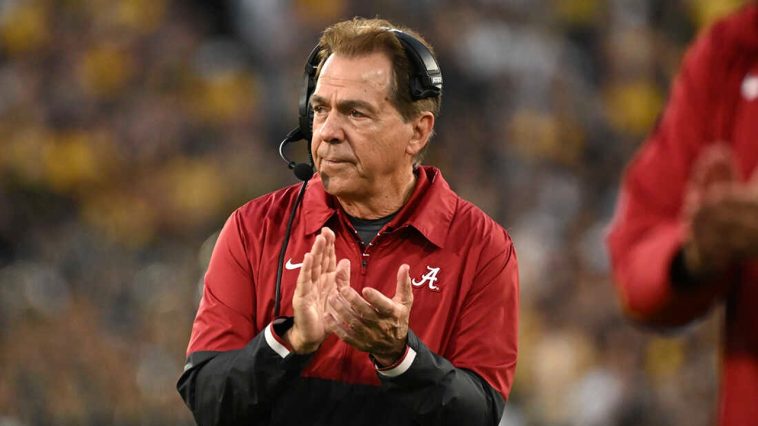A monumental period in college football history culminated on Wednesday. It was an era defined by dominance, by unrivaled success. With seven national championship victories under his belt, and after leading two different colleges to victory, 72-year-old Nick Saban has announced his retirement.
His legacy within college football is unparalleled, with a lifetime record of 292-71-1 across his 28-year tenure as a college head coach. Saban also dabbled in NFL coaching for two years with the Miami Dolphins, from 2005 to 2006, where he maintained a record of 15-17.
Reports of his retirement arrived somewhat unexpectedly. Despite his advancing age, Saban had shown no previous signs of contemplating retirement. In a conversation with ESPN just this past November, he stated that thinking about retirement was a sign that one had already mentally checked out — a state Saban made clear he was not in. This sentiment was backed by Alabama’s top-tier recruitment class for the coming season and active involvement in the transfer portal following the recent end of its season on January 1, in the College Football Playoff semifinals.
Saban’s coaching journey commenced in 1973 as a graduate assistant at Kent State, his alma mater. Seventeen years later, he scored his first head coach position at Toledo. Following that, he served the Cleveland Browns as defensive coordinator for four years before taking the reins at Michigan State in 1995. His true rise to national prominence, however, didn’t occur until his tenure at LSU.
It was at Louisiana State University that Saban’s name became synonymous with success. His guidance led the Tigers to the 2003 BCS national title, the first of Saban’s seven championships. Saban was known for his coaching philosophy, often encapsulated by the term ‘the process’, which emphasized the importance of focusing on immediate tasks, staying present, and avoiding concern about outcomes. Saban’s warning against ‘rat poison’, his term for positive press potentially distracting his team from their ultimate goal, was another popular catchphrase.
In 2007, when Saban assumed control of Alabama’s team, the Crimson Tide was in a period of decline unusual for such a prestigious program. Their record in 2006 was a disappointing 6-7, and they had not ranked in the AP poll’s top 10 since 1999. Saban, however, quickly instituted a turnaround. By his third season, Alabama had captured a national title, and scored No. 1 rankings in his fifth and sixth seasons.
Speaking to ESPN after his appointment at Alabama, Saban shed light on his motivation: “A large part of this is about legacy. Achieving a national championship at LSU and then doing the same at another SEC institution like Alabama would create a distinctively unique legacy.” Following his guidance, Alabama secured at least 10 victories in Saban’s final 16 seasons. This record stands as the longest streak in the AP poll era. Moreover, Alabama partook in the College Football Playoff in eight of its 10 seasons of existence.
One standout aspect of Saban’s time at Alabama was his adaptability. Initially, he implemented a strategy centered around solid defense and ground offense. However, in response to the evolving landscape of college football leaning more toward spread offenses, Saban changed tacks. Alabama began to be recognized for its highly efficient, explosive offense, led by NFL quarterbacks Jalen Hurts, Tua Tagovailoa, and Mac Jones.
Explaining his decision to switch strategies in 2021, Saban said, ‘We had to change our style and be able to outscore people. Even though we had a good defense, when we faced Ole Miss and teams using spread offenses and RPOs, they still managed to score points. I decided we had to adapt.’ Therefore, even amidst his string of successes, Saban demonstrated a willingness to adjust.
Over his tenure at Alabama, Saban mentored four Heisman Trophy winners: Mark Ingram and Derrick Henry, both running backs; DeVonta Smith, a wide receiver; and Bryce Young, a quarterback. As of now, he holds the record for most first-round draft picks, totaling 49. This number is expected to increase in April.
Saban’s final season at Alabama was testament to his coaching skill. It had a rocky start, with an unexpected loss to Texas and a struggle against Central Florida. Unlike most Saban-led seasons, dominance was not a defining trait. However, a come-from-behind victory over the previously unbeaten Georgia catapulted Alabama into the Playoff, defying expectations and providing evidence of the resilience within the team.
Although Saban’s final season did not end with the ultimate victory, as Alabama lost to the Michigan Wolverines in the playoff, it was undeniably impressive. Post the Georgia upset, Saban praised his team for their display of character and resilience. He noted, ‘I couldn’t be prouder of a team that has come so far. The perseverance these guys have shown, their capacity to overcome adversity … it’s a great example for anyone wishing to be successful.’
With Saban’s departure, Alabama now faces the daunting task of selecting a new head coach. Names like Oregon’s Dan Lanning, Notre Dame’s Marcus Freeman, and Clemson’s Dabo Swinney are already being suggested. Filling the shoes of such an iconic figure will undoubtedly be challenging for whoever secures the role.
The transition between leadership is always a rather complex one, particularly when the predecessor enjoys the status of a legend. Yet, the scenario at Alabama goes beyond that. Taking over after someone universally regarded as the greatest of all time is an almost insurmountable challenge. Regardless, as Saban has often preached, it’s all part of ‘the process’.



